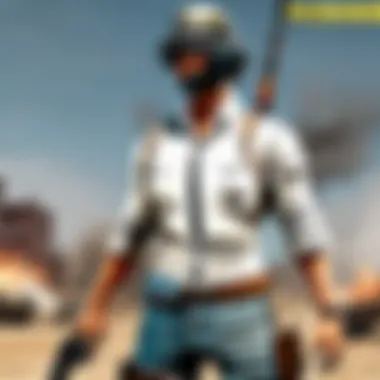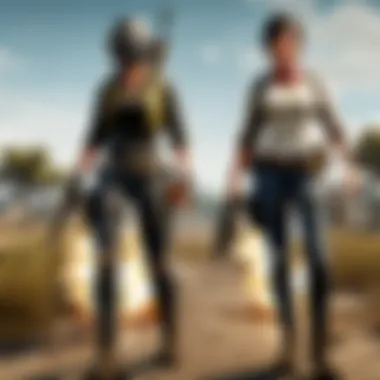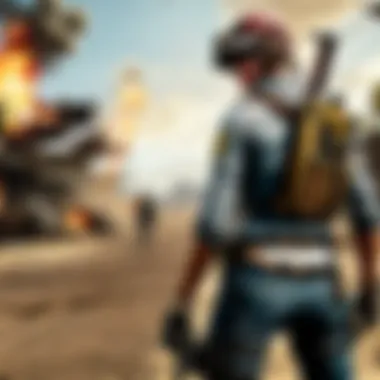Exploring 12 Unique PUBG Mini-Games: A Deep Dive


Intro
The world of PUBG is ever-evolving, and with it comes a treasure trove of mini-games that not only entertain but also allow players to hone their skills. These mini-games are more than just a break from the intense battle royale format; they serve as platforms for creativity and innovation within the PUBG community. Each mini-game introduces unique mechanics and challenges, providing new ways to engage with friends and rivals alike.
In this guide, we delve into twelve distinctive mini-games that showcase the versatility of PUBG. Whether it's mastering vehicle maneuvers in a racing challenge or working collaboratively in a team-based scavenger hunt, each mini-game adds a layer of complexity to the traditional PUBG experience.
The discussions in this article will cover not only the mechanics but also the strategic approaches necessary for excelling in these diverse formats. By the end, you'll gain a deeper understanding of how these mini-games can enhance your skills, foster camaraderie within the PUBG community, and ultimately elevate your overall gaming experience.
Without further ado, let's jump into the Game Updates that accompany these thrilling mini-games.
Prolusion to PUBG Mini-Games
In the vast realm of PlayerUnknown's Battlegrounds, or PUBG, mini-games play a crucial role in shaping the player experience. They serve as a breath of fresh air amidst intense battles, giving players a chance to engage differently with the game. By mixing elements of fun and competitive spirit, these mini-games invite players to hone their skills while enjoying creative challenges.
Overview of PUBG and Its Gameplay Mechanisms
PUBG, at its core, is a battle royale game where survival depends on strategy, precision, and, often, sheer luck. Players parachute onto an expansive island, scavenge for weapons and supplies, and engage in combat until only one remains standing. However, it is not merely about shooting opponents; it includes an intricate dance of tactical decisions, positioning, and environmental awareness. These mechanisms—such as circle closure and resource management—enhance the game’s complexity and excitement. Mini-games take these mechanics and transform them into unique scenarios that allow players to focus on particular skills or themes, often enhancing their overall PUBG experience.
For instance, a mini-game emphasizing building and resource allocation can improve a player's awareness of inventory management in a real match, whereas one that focuses on vehicle maneuvers can refine driving skills crucial for survival. In short, these games aren't just side ventures; they are beneficial exercises for players eager to elevate their gameplay.
The Evolution and Popularity of Mini-Games
The emergence of mini-games within PUBG reflects the evolving landscape of gaming itself. Initially, players found creative ways to adapt the main game modes into smaller, self-regulated challenges. Over time, these spontaneous creations gave birth to a wealth of innovative mini-game formats. Players began to engage in everything from target practice competitions to scavenger hunts, fueling a community spirit that transcends the classic battle royale format.
Today, PUBG mini-games are a staple in player communities, promoting not just skill enhancement, but also camaraderie among gamers. As players share strategies and experiences related to mini-games, they organically contribute to a vibrant culture that thrives on shared gameplay. This backing fosters continuous interest and participation among both new and seasoned players who wish to connect with each other in ways beyond traditional combat.
"Mini-games in PUBG are like the icing on the cake; they not only please the players but also deepen the overall flavor of the gaming experience."
As such, the evolution of these mini-games manifests the dynamic nature of the PUBG community. They embody adaptability and inventiveness, keeping the game fresh and engaging while encouraging players to push the limits of their skills. In essence, mini-games are a testament to the enduring creativity of the PUBG player base, making them indispensable components of the broader gaming ecosystem.
The Importance of Mini-Games in PUBG
Mini-games have carved a niche within the vast landscape of PlayerUnknown's Battlegrounds (PUBG). They stand as more than just fleeting distractions from the main battle royale experience. Their significance lies in how they not only enhance players' skill sets but also cultivate an environment ripe for community interaction.
Enhancing Player Skills and Strategies
In the high-octane world of PUBG, where split-second decisions can seal your fate, the mini-games serve as vital training grounds. They allow players to hone specific skills without the pressure of traditional gameplay. Take, for instance, the tactical shooting mini-game. Here, players can focus on perfecting their aim, mastering bullet drop, and learning recoil patterns, all in a no-risk setting.
Furthermore, some mini-games emphasize strategic thinking and adaptability. Consider a scenario where players have to survive a shrinking safe zone filled with obstacles. This not only sharpens your tactical mind but also gets you used to the dynamics of combat situations. Consequently, players enter the actual matches better equipped to navigate through the chaos.
Moreover, the repeatability of these mini-games means players often refine their strategies over time. Those who engage regularly can spot patterns, experiment with different techniques, and ultimately develop a more comprehensive understanding of game mechanics. This learning curve may seem gradual but translates into tangible advantages in competitive situations.
Fostering Community Engagement Among Players
Beyond skill development, mini-games play a crucial role in fostering a sense of belonging within the PUBG community. They offer players an opportunity to socialize and form bonds in less competitive environments.
For instance, a group of friends might find themselves diving into a fun mini-game after a long day of serious matches. Perhaps it’s a custom server dedicated to quirky variations like vehicle races or survival challenges. These moments of levity encourage teamwork and camaraderie, allowing players to connect beyond just ranking and kill counts.


Additionally, social media platforms, forums, and streaming sites buzz with interactions centered around mini-games. Players share tutorials on best strategies, post highlights of unforgettable moments, and even challenge each other to beat records. This community-driven discourse strengthens ties, making players feel part of something larger than just a game.
Mini-games contribute to a rich tapestry of experiences that transcend typical gameplay dynamics. They emphasize growth, connection, and even creativity within the community. Ultimately, these elements blend seamlessly into PUBG's ecosystem, enriching the player journey on multiple fronts.
"Mini-games are like a breath of fresh air in the sometimes tense battleground atmosphere, providing fun while honing skills that matter."
Finale
Through the lens of skill enhancement and community engagement, the importance of mini-games in PUBG becomes crystal clear. They are indispensable tools for improvement and interaction, allowing players to refine their combat capabilities and foster lasting connections within the gaming world.
A Closer Look at Twelve Mini-Games
In the world of PUBG, mini-games surface as diamonds hidden in the rough of battle royale chaos. They serve a dual purpose: offering players a break from intense matches while refining their skills in a laid-back, yet strategic environment. Through a closer examination of these twelve mini-games, enthusiasts can grasp their individual elements and benefits, allowing a richer experience in PUBG.
Mini-Game One: Description and Objectives
Gameplay Mechanics
This mini-game invites players to showcase their sharpshooting abilities in a timed environment. The mechanics revolve around hitting targets strategically placed at varying distances. Players have limited ammunition and a ticking clock, emphasizing both precision and speed. The key characteristic here is the balance between accuracy and urgency; it’s not just about being a good shot, but also about time management. This approach is a beneficial choice for honing quick decision-making skills.
One unique feature lies in interactive targets; some may move or even provide power-ups, adding an exciting twist to the shooting mechanics. However, the downside can be the steep learning curve for new players, which may lead to frustration instead of fun.
Strategies for Success
To thrive in this mini-game, players should focus on prioritizing targets based on their movement and potential rewards. Understanding the patterns of the targets can give players an edge. A valuable strategy is to set personal benchmarks rather than just aiming for high scores; improving from your previous attempts can foster a sense of accomplishment.
A notable aspect of strategies is the importance of adaptability since conditions can change rapidly due to the moving targets. While this makes for a dynamic playstyle, it can also be disheartening for some, especially if they miss a crucial shot during a tense moment.
Mini-Game Two: Description and Objectives
Gameplay Mechanics
This mini-game shifts the focus to strategic thinking and teamwork. Players are divided into two teams tasked with capturing a designated flag within a complex map filled with obstacles and hiding spots. The mechanics rely not only on shooting skills but also on navigating the terrain and coordinating with teammates. The standout quality here is the emphasis on communication. Teams that work together generally fare much better than lone wolves.
A distinct feature of this mode is the limited respawns, forcing players to think twice before jumping into the fray. On the downside, this can lead to moments of inactivity, which might discourage some players who prefer a more action-packed experience.
Strategies for Success
Successful teams often have clear plans and designate roles. For instance, having a scout to relay enemy positions can turn the tide of the game. Another key strategy includes using the map effectively; players should familiarize themselves with potential cover spots and ambush points.
However, teamwork can also mean dealing with conflicts regarding strategy; differing tactics among players may lead to disruptions in performance. Managing disagreements effectively and ensuring everyone is on the same page is essential for victory.
Mini-Game Three: Description and Objectives
Gameplay Mechanics
In this variant, players enter a race against time, navigating across diverse terrains on various vehicles. The mechanics are all about speed and control, emphasizing smooth driving and tactical advantage in taking shortcuts. One characteristic of this game is how it showcases the vast environment of PUBG, providing a change of pace from typical battle engagements.


An unique feature is the dynamic weather, which influences vehicle handling differently based on conditions. While this adds a layer of challenge, it can also be a source of frustration for players unaccustomed to adapting to sudden environmental shifts.
Strategies for Success
To ace this mini-game, mastering the different vehicle types is crucial; each comes with its own handling quirks. Familiarity with the map will help players identify and utilize shortcuts effectively. Moreover, practicing under various weather conditions can prepare players for unexpected obstacles.
However, intense competition can breed impatience, leading some players to take reckless risks. Balancing speed with calculated maneuvers will always yield better results than mindless acceleration.
Mini-Game Four: Description and Objectives
Gameplay Mechanics
This mini-game brings in the essence of strategy games, focusing on resource management. Players need to gather supplies, build structures, and outwit opponents, all while trying to fortify their position. The mechanics encourage players to think critically about resource allocation, which could mean victory or defeat.
The standout feature involves crafting elements; players can innovate their defensive strategies by constructing traps or shelters that may not be immediately available in battle royale matches. Despite the creativity it allows, some players may find resource gathering tedious or frustrating, possibly resulting in a slower-paced game.
Strategies for Success
To perform well, players must prioritize resource gathering early on. Creating a solid base is essential for fending off opponents who may attack. Collaboration can also significantly enhance success; sharing resources typically strengthens the group’s overall position.
Nonetheless, this strategy can be double-edged; over-reliance on a single plan can lead to unpredictable scenarios where players may find themselves unprepared for sudden threats.
Mini-Game Five: Description and Objectives
Gameplay Mechanics
In this survival challenge, players must collect items scattered throughout a designated area while avoiding hostile NPCs. The key mechanics revolve around stealth, item management, and evasion techniques. The best players know when to engage and when to flee. The central characteristic of this mini-game is the psychological aspect of survival; players not only have to hunt for items but also manage their fear and instinct to fight.
One unique aspect is the potential for environmental advantages; hiding in bushes or using terrain for cover can be game-changers. However, this stealth approach may lead to passive gameplay, causing some to feel that the pace doesn’t suit their style.
Strategies for Success
Players often benefit from a slow and steady approach, prioritizing stealth over aggression. Learning to read the NPCs’ behaviors can help players find opportune moments to collect valuable resources. Creating a checklist of necessary items can streamline planning in the heat of the moment.
However, adopting a cautious mindset can sometimes lead to missed opportunities if players do not strike when the iron is hot. Balancing caution with aggression is key; knowing when to take the leap can be crucial in this mini-game.
Analyzing Player Feedback on Mini-Games
Understanding how players feel about PUBG's mini-games adds a rich layer to this article. Player feedback reflects not just enjoyment and skill enhancement, but also shapes future developments. It’s crucial to delve into these sentiments as they reveal common threads that connect players, fostering a sense of community and shared experience. Moreover, by recognizing player preferences, developers can fine-tune mini-games, making them more engaging and inclusive.
Common Themes and Preferences Among Players
Reviewing player feedback uncovers consistent themes that can guide both gamers and developers. For instance:
- Skill-Based Competition: Many players enjoy mini-games that require strategy and quick reflexes, effectively sharpening their in-game skills. Games like the Team Deathmatch mode showcase this, as players often share strategies on forums and social media to improve their gameplay.
- Community Interaction: A palpable preference for mini-games that encourage teamwork and social interaction has emerged. Collaborative scenarios, like Zombie Survival Challenges, have players working together to achieve a common goal. This not only enhances gameplay but also builds camaraderie among participants.
- Diversity in Gameplay: There's a notable call for more variety in mini-games to prevent repetition. Players appreciate fresh content that introduces unique mechanics, such as the Parkour Challenge, engaging them with new experiences that differentiate from standard battle royale gameplay.
"Players always want to feel challenged but also connected. When a mini-game nails both, it's golden!"


This feedback is invaluable, as it highlights what players cherish. By integrating these themes, developers can create richer experiences that not only satisfy current players but also attract new ones.
Impact on Overall Gameplay Experience
The influence of these mini-games extends beyond just fun and games; they impact the wider PUBG experience. Here are some critical areas to consider:
- Skill Enhancement: Mini-games often serve as a training ground, forging better players who perform well in main matches. This dual purpose rings true for fans who love games like the Sniper Challenge, where honing sniping skills has direct applications in competitive settings.
- Replay Value: Engaging mini-games encourage players to return, thus enhancing overall game longevity. Players usually seek to practice or become proficient at mini-games, which translates into a more active player base.
- Community Engagement: It’s common to see players forming teams specifically for mini-games, thereby nurturing a vibrant community. Events like tournaments hosted on platforms such as Reddit create buzz and keep the player base active.
- Feedback Loop: As players engage in these mini-games and share their feedback, developers receive insights that foster innovation. Active communication through Reddit or social media allows the community to influence game design, creating a cycle of improvement and responsiveness.
To sum up, analyzing player feedback on mini-games helps to align gaming experiences with player expectations. As feedback shapes future developments, understanding player preferences can enhance engagement, ensuring PUBG remains at the forefront of the gaming landscape.
Future of Mini-Games in PUBG
The future of mini-games in PUBG holds significant importance in shaping both the game’s trajectory and community engagement. Mini-games often serve as a refreshing break from the monotonous Battle Royale format. They allow for creativity and experimentation, appealing to diverse player preferences and varying skill levels. As gaming evolves, the introduction of innovative mini-games can usher in new genres, enhance player satisfaction, and sustain interest in the PUBG universe.
Trends and Innovations to Watch For
As we look ahead, several trends are emerging that could redefine the mini-game landscape in PUBG:
- Cross-Platform Play: With gaming networks becoming increasingly integrated, mini-games that allow cross-platform participation can broaden the target audience. Players on mobile, console, and PC can compete or collaborate, creating a more vibrant community.
- Augmented Reality Elements: Although predominantly a shooter, PUBG could benefit from AR capabilities in mini-games. Imagine mini-challenges where players use real-world settings to influence game play. This would create a unique fusion of reality and the PUBG universe.
- Skill-Based Matching: As mini-games proliferate, implementing skill-based matchmaking can improve player experience. By pairing players of similar abilities, the competition becomes fairer, leading to enhanced engagement.
- Regular Events and Seasonal Themes: Just like how Fortnite integrates seasonal themes, PUBG can adopt a rhythm of rotating mini-games that reflect current events or seasons, maintaining player curiosity.
- Dynamic Environments: Future mini-games might take advantage of destructible environments or changing terrain, allowing for tactics to evolve mid-game. This would demand adaptability and quick thinking, enriching the gameplay.
"The possibilities for mini-games in PUBG are rather endless when creativity meets technological advancements."
Potential Challenges and Opportunities
With innovation comes challenges that the developers need to navigate smartly:
- Balancing Gameplay: Introducing new mini-games must not disrupt the overall game balance. If certain mini-games become overly popular or rewarding, they could skew player expectations and gameplay dynamics.
- Maintaining Community Interest: The challenge will be keeping the community engaged with fresh content. Developers will need to strike a balance between nostalgia for beloved classics and the introduction of new options that don’t alienate long-term fans.
- Technical Limitations: Depending on the complexity of new features, technical limitations may arise. Mini-games that require high-performance graphics or processing capabilities must be optimized for various devices to ensure accessibility for all players.
Despite these hurdles, the potential opportunities far outweigh the concerns:
- Community Building: Mini-games can help forge stronger community ties, as players collaborate on objectives, forming friendships and alliances that carry over to the main game.
- Expanding Player Base: Every new mini-game can attract different demographics. Competitive and casual players alike can find something that appeals to them in this realm, expanding PUBG’s reach in the gaming market.
- Sponsorship Deals and Esports: Competitive mini-games can open new revenue streams through sponsorships and tournaments. Developers could host events that spotlight player skills in unique formats, thereby increasing viewership and player engagement in esports.
Summary
In summary, the future of mini-games in PUBG is an unfolding narrative ripe with potential and complexity. By observing trends and concurrently addressing challenges, there’s a splendid opportunity to innovate and refine the gaming experience. This evolution isn’t merely about adding variety; it is about fostering an enduring community and enhancing player engagement in a rapidly shifting gaming landscape.
Closure
In the realm of PUBG, mini-games serve as a significant aspect that should not be overlooked. These mini-games enhance the overall gameplay experience by providing players with alternative objectives and scenarios, fostering a vibrant community where creativity and competition can thrive. The unique mechanics presented in each mini-game allow for the honing of skills while engaging with fellow players in a way that traditional matches might not promote.
Recapping the Significance of Mini-Games
One cannot understate the role of mini-games in shaping the PUBG environment. They encourage players to step outside their comfort zones, try new strategies, and engage in different styles of play. For example, the variation in objectives forces players to adapt their tactics, which can then be translated into standard gameplay.
- Skill Development: Mini-games often require precision, timing, and decision-making, which can enhance a player's abilities in the main game.
- Social Interaction: Many mini-games are designed for cooperation and competition, drawing players together and fostering friendships.
- Creativity and Variation: These games also introduce fresh content, keeping the community lively. Players tend to enjoy mini-games that break the monotony of battle royale experiences, providing a breath of fresh air.
Ultimately, mini-games nurture a diverse gameplay environment within PUBG, encouraging both new players and veterans to engage in ways that are novel and fulfilling.
Final Thoughts on Player Engagement
As we draw this guide to a close, player engagement emerges as a critical theme when discussing mini-games. The allure of mini-games lies not just in their mechanics but also in their ability to create bonds among players. Engaged players often lead to a more dynamic community, enriching the gameplay experience.
- Fan Involvement: Many enthusiasts contribute to the evolution of mini-games, suggesting variations and new rules that keep the gameplay fresh.
- Effective Use of Time: Mini-games offer a distinct way for players to utilize their downtime between regular matches, ensuring that even time off can be engaging.
- Feedback Loop: The reactions and interactions from the players allow developers to innovate and enhance gameplay further, leading to continuous improvement.



